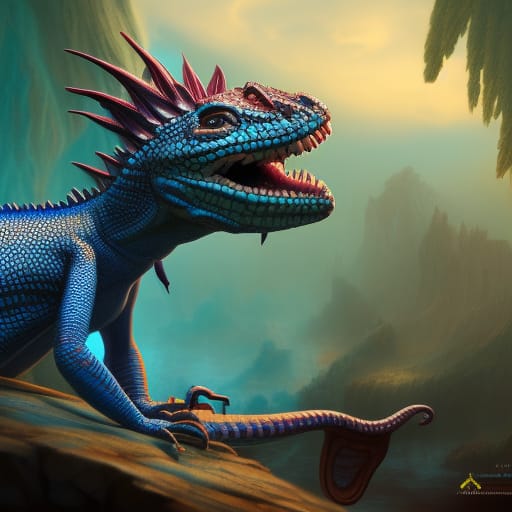Flame-Striped Drake
The Flame-Striped Drake is a dangerous animal, not due to predatory tendencies but due to it's skin that secretes a neurotoxin that is highly lethal. They are actually rather docile creatures but due to their habitat they can be hard to spot and many unsuspecting travelers have died from failure to notice them. In addition they are actually venomous as well and prone to biting when scared.
Basic Information
Anatomy
They are small lizards with slick smooth skin and large red crests along their spines and heads. Their feet are clawed for climbing and digging for food. They grow to be about 5 inches long head-and-body with a tail roughly 4 inches long. Despite their length they only stand about 2 inches tall with about an additional inch for the tallest part of their crests.
Genetics and Reproduction
The flame-striped drake lays a clutch of up to three eggs at a time and they take about about 2 months to hatch. The mother does not remain with the eggs once they have been deposited in a safe hole she has dug for them.
Growth Rate & Stages
They have three stages of life, egg, juvenile, and adult.
Egg:
This is the two month period in which they grow and develop before hatching.Juvenile:
After hatching the flame-striped drake is tiny and while it has the skills and instincts to survive on it's own is not fully matured and it is at this stage that they are still considered harmless as the neurotoxin they secrete is not as strong. This stage is also the most dangerous for them because they are easy prey for larger predators.Adult:
The main change between Juvenile and Adult is their size and the potency of their neurotoxin.Dietary Needs and Habits
They are herbivorous by nature though they will occasionally eat small bugs. They are particularly fond of leaves and berries.
Behaviour
These are very curious creatures which adds to the danger as they often scuttle towards new sounds and smells. Their small size and the fact their blue coloration matches many of the plants in their home forest means that they are hard to spot until it is too late in many cases.
Additional Information
Uses, Products & Exploitation
They are often caught by those who live in areas where they are common and used to poison arrows and blades, the process is difficult and dangerous but makes for the warriors of those areas to be highly feared and dangerous. In some areas they are also used as a rare delicacy though they must be cooked a precise way and amount in order to be safely consumed. Many nobles have died due to their wish to try this cuisine despite the risk.
Geographic Origin and Distribution
They are generally found in the Aubren with a higher concentration in the southern forests of the continent. Despite their size and docile natures they are listed as one of the biggest risks when planning expeditions to those areas.
Lifespan
5 years
Average Height
2 Inches
Average Length
Nose to tip of tail 9 inches
Body Tint, Colouring and Marking
Their coloration is a bright neon blue with a dark red ridge and crest.
Geographic Distribution





"This is the Geico Gecko's cousin from the hood" -My Nana